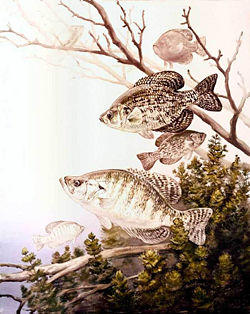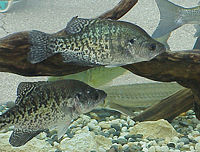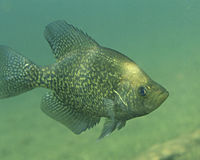Crappie
 From Nwe
From Nwe | Pomoxis | ||||||||||||
|---|---|---|---|---|---|---|---|---|---|---|---|---|

Black (top) and white crappie (P. nigromaculatus & P. annularis) |
||||||||||||
| Scientific classification | ||||||||||||
|
||||||||||||
|
|
||||||||||||
|
Crappie (plural: Crappie or crappies) is the common name for either of two species of North American freshwater fish comprising the genus Pomoxis of the sunfish family (family Centrarchidae), the white crappie (Pomoxis annularis) and the black crappie (P. nigromaculatus). These also have many other common names, with the P. annularis known as the calico bass and P. nigromaculatus known variously as calico bass, grass bass, oswego bass, speckled bass, and strawberry bass.
Both species of crappie are very popular game fish. The Pomoxis species also are often considered to be among the best tasting freshwater fish. Ecologically, they provide important roles in food chains, consuming fish, zooplankton, insects, and crustaceans and being consumed by larger fish, birds (great blue heron, and so on), mammals (otter and mink), and reptiles (turtles). Their large dorsal and anal fins, complete with spines, offers some protection against predators. They also can produce numerous eggs, from 10,000 to 200,000 during a spawning period.
These functions reflect the principle of bi-level functionality, whereby the Pomoxis species not only advance their own individual function (reproduction, survival), but also provide a larger function for the ecosystem and for humans.
Overview and description
Centrarchidae, the family to which Pomoxis belongs, is one of about 160 families in the Perciformes order. Known as the sunfishes, members of this family are characterized by a laterally compressed body, anal fin spines, and a lateral line (Nelson 2006).
Pomoxis is one of eight genera in Centrarchidae. Among other well-known members of the family are the bluegill (Lepomis macrochirus) and pumpkinseed (Lepomis gibbosus), as well as the basses (genus Micropterus, although members of other genera also include representatives with the common name of bass).
Pomoxis has two extant species, P. annularis and P. nigromaculatus. Both are referred to by the common name of crappie, with the former being called the white crappie and the later the black crappie. However, both species also have common names with the term bass as well. These two species are most readily distinguished by the number of spines on the dorsal fin, with the white crappie having six spines and the black crappie having seven or eight spines. The type species is P. annularis, the white crappie.
Both species of crappie as adults feed predominantly on smaller species, including the young of their own predators, which include the northern pike, muskellunge, bass, and walleye. They have diverse diets, however, including zooplankton, insects, and crustaceans (Frose and Ortañez 2008a, 2008b; Adams 2000).
By day, crappie tend to be less active and to concentrate around weed beds or submerged objects, such as logs and boulders; they feed especially at dawn and dusk, moving then into open water or approaching the shore (Adams 2000; Nature Serve 2008a, 2008b).
Because of their diverse diets, crappie may be caught in many ways, including casting light jigs, trolling with minnows or artificial lures, using small spinnerbaits, or using bobbers. Crappies are also popular with ice-fishers, as they are active in winter (Adams 2000; Nature Serve 2008a, 2008b; Bridges).
The genus name Pomoxis derives from the Greek πώμα (cover, plug, operculum) and οξύς (sharp). The common name (also spelled croppie or crappé), derives from the Canadian French crapet, which refers to many different fishes of the family Centrarchidae. Both "crappie" and "crappies" are acceptable as the plural, although in some cases the term crappies tends not to be used, by analogy with fishes, except to refer to types of crappie.
White crappie
The white crappie (Pomoxis annularis Rafinesque, 1818) is native throughout the eastern half of Canada and the United States, and has been widely introduced in the west as well.
The dorsal fin of the white crappie has six spines. The maximum recorded length for a white crappie is 53.0 centimeters (21 inches), with a maximum weight of almost 2.35 kilograms (more than 5.18 pounds); it can live as long as ten years (Frose and Ortañez 2008a).
These species prefers slower-moving water, often turbid, whether a backwater of a small creek or a large lake.
When spawning, the white crappie deposits its eggs on plant surfaces (Frose and Ortañez 2008a) or in poorly-defined nests in shallow water (Nature Serve 2008a).
This very prolific fish may overpopulate small bodies of water under 40 hectares (100 acres) in area.
Black crappie
The black crappie (Pomoxis nigromaculatus Lesueur, 1829) is very similar to P. annularis in size, shape, and habits, except that it is darker, with a pattern of black spots. It is most accurately identified by the seven or eight spines on its dorsal fin. The oldest recorded age of a specimen is fifteen years, although seven years is a more typical life span for the species (Adams 2000; Frose and Ortañez 2008b).
The black crappie's range is uncertain, since it has been so widely transplanted, but it is presumed to be similar to the white crappie's; as of 2005, populations existed in all of the lower 48 states (Frose and Ortañez 2008b; TPWD 2008).
The black crappie tends to prefer clearer water than the white crappie does. Its diet, as an adult, also tends to be less dominated by other fish than that of the white crappie (Frose and Ortañez 2008b; TPWD 2008).
The breeding season varies by location, due to the species’ great range; breeding temperature is 14‒20 °C (58‒68 °F) and spawning occurs between April and June (Adams 2000; Frose and Ortañez 2008b). Spawning occurs in a nest built by the male, who guards the eggs and young (Adams 2000; Frose and Ortañez 2008b; Nature Serve 2008b). The female black crappie may spawn several times during the spawning period, with several males, and bear 10,000 to 200,000 eggs (Adams 2000).
Like P. annularis, P. nigromaculatus is very prolific and can tend to overpopulate its environment, with negative consequences both for the crappie and for other fish species (Adams 2000).
Crappie angling
Angling for crappie is popular throughout much of North America. Methods vary, but among the most popular is called "spider rigging," a method characterized by a fisherman in a boat with many long fishing rods pointing away from the angler at various angles like spokes from a wheel (Neporadny 2008). Anglers who employ the spider rigging method may choose from among many popular baits. Some of the most popular are plastic jigs with lead jig heads, crankbaits, or live minnows.
Many anglers also chum or dump live bait into the water to attract the fish hoping the fish will bite their bait. Crappie are also regularly targeted and caught during the spawning period by fly fishermen, and can be taken from frozen ponds and lakes in winter by ice fishing.
References
ISBN links support NWE through referral fees
- Adams, R. 2000. Pomoxis nigromaculatus. Animal Diversity Web. Retrieved December 07, 2008.
- Bridges, A. n.d. Black crappie. Florida Museum of Natural History, Ichthyology Department. Retrieved December 7, 2008.
- Ellis, J. 1993. The Sunfishes: A Fly Fishing Journey of Discovery. Bennington, VT: Abenaki Publishers. ISBN 0936644176.
- Frose, R., A. K. Ortañez. 2008a. Pomoxis annularis White crappie. FishBase. (R. Froese and D. Pauly, editors). Retrieved December 6, 2008.
- Frose, R., A. K. Ortañez. 2008b. Pomoxis nigromaculatus Black crappie. FishBase. (R. Froese and D. Pauly, editors). Retrieved December 6, 2008.
- Integrated Taxonomic Information System (ITIS). 2004. Pomoxis Rafinesque, 1818. ITIS Taxonomic Serial No.: 168165. Retrieved December 7, 2008.
- Malo, J. 1981. Fly-Fishing for Panfish. Minneapolis, MN: Dillon Press. ISBN 0875182089.
- Nature Serve. 2008a. Pomoxis annularis—(Mitchill, 1814). Nature Serve. Retrieved December 6, 2008.
- Nature Serve. 2008b. Pomoxis nigromaculatus—(Mitchill, 1814). Nature Serve. Retrieved December 6, 2008.
- Nelson, J. S. 2006. Fishes of the World, 4th edition. Hoboken, NJ: John Wiley & Sons. ISBN 0471250317.
- Neporadny, J. 2008. Super crappie systems: Scaled down spider rigging. In-Fisherman.com. Retrieved December 7, 2008.
- Rice, F. P. 1964. America's Favorite Fishing: A Complete Guide to Angling for Panfish. New York: Harper Row.
- Rice, F. P. 1984. Panfishing. New York: Stackpole Books. ISBN 0943822254.
- Texas Parks and Wildlife Department (TPWD). 2008. Black crappie (Pomoxis nigromaculatus) Texas Parks and Wildlife Department. Retrieved December 7, 2008.
- Crappie.net - Information portal dedicated to solely crappie fishing
Credits
New World Encyclopedia writers and editors rewrote and completed the Wikipedia article in accordance with New World Encyclopedia standards. This article abides by terms of the Creative Commons CC-by-sa 3.0 License (CC-by-sa), which may be used and disseminated with proper attribution. Credit is due under the terms of this license that can reference both the New World Encyclopedia contributors and the selfless volunteer contributors of the Wikimedia Foundation. To cite this article click here for a list of acceptable citing formats.The history of earlier contributions by wikipedians is accessible to researchers here:
The history of this article since it was imported to New World Encyclopedia:
Note: Some restrictions may apply to use of individual images which are separately licensed.
↧ Download as ZWI file | Last modified: 02/04/2023 10:30:41 | 2 views
☰ Source: https://www.newworldencyclopedia.org/entry/Crappie | License: CC BY-SA 3.0
 ZWI signed:
ZWI signed:

 KSF
KSF